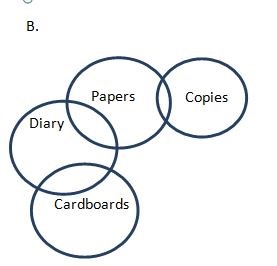Question
Statements: Some papers are copies. No copy is a
diary. Some diary are cardboard. Conclusions:I. No diary is papers. II. Some papers are diary. In each of the questions below are given three statements followed by three conclusions numbered I and II. You have to take the given statements to be true even if they seem to be at variance with commonly known facts. Read all the conclusions and then decide which of given conclusions logically follows from the given statements disregarding commonly known facts. Give answerSolution
Some papers are copies (I) + No copy is a diaries (E) = Some papers are not diaries (O). Hence, neither conclusion I nor II will follow. However, Conclusion I and II make a complementary pair, hence, either conclusion I or II will follow. ALTERNATE METHOD: All possible cases: 

 In case A, no paper is a diary and in case B & C some papers are diary. Thus, either of them is true.
In case A, no paper is a diary and in case B & C some papers are diary. Thus, either of them is true.
Which award will RRR star Ram Charan receive at the Indian Film Festival of Melbourne (IFFM) 2024?
Which organization's Director (Finance) has recently assumed the additional charge of Chairman and Managing Director of the company, according to the in...
What is the projected household savings in India for FY25, according to SBI?
PhonePe signed an MoU with which organization to digitally register informal micro enterprises (IMEs) across India?
India Post’s first Gen Z–themed campus Post Office has been inaugurated at which institution?
In which year did the establishment of the Insurance Regulatory and Development Authority of India (IRDAI) take place?
What reform did the Department of Economic Affairs bring to the Securities Contracts (Regulation) Rules, 1957?
Dr Tehemton E Udwadia, best known as the father of __________.
Which sector accounted for over half of the personal loan market according to RBI’s State of the Economy report?
What is the approximate altitude of the geostationary orbit from the Earth's surface?


